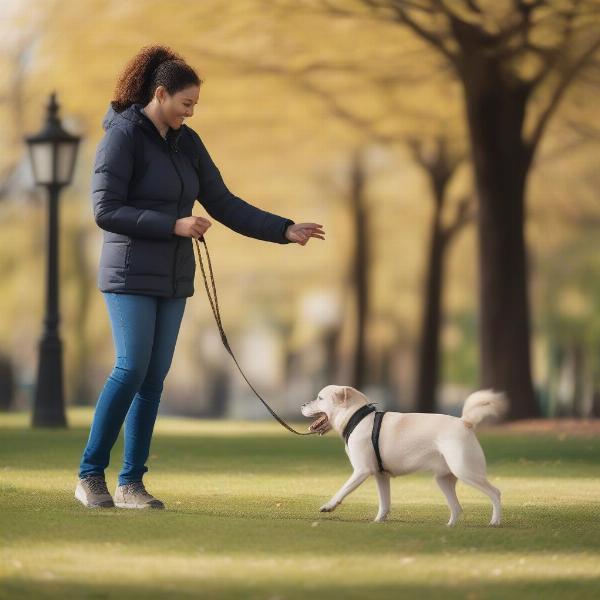A dog extended leash can be a valuable tool for dog owners, offering a balance between control and freedom for their furry friends. However, using them responsibly and effectively is crucial for both the dog’s safety and the enjoyment of others. This comprehensive guide will delve into the various aspects of using a dog extended leash, from choosing the right one to mastering proper handling techniques.
Choosing the Right Dog Extended Leash
The market offers various types of extended leashes, each with its pros and cons. Retractable leashes are popular for their adjustable length, but they require careful handling due to potential hazards like rope burns or sudden recoils. A traditional long line, typically made of nylon or rope, provides more control but can be cumbersome. When selecting a leash, consider your dog’s size, temperament, and training level. For larger or more powerful breeds, a sturdy leash with a comfortable grip is essential.
For dogs prone to pulling, a harness and a non-retractable long line may be a safer option. Puppies and smaller breeds can benefit from a lightweight retractable leash with a gentle retraction mechanism.
Mastering Extended Leash Handling Techniques
Proper handling is key to maximizing the benefits and minimizing the risks of an extended leash. Maintain a comfortable grip and avoid wrapping the leash around your hand or any part of your body. Sudden jerks can cause injury to both you and your dog. Practice consistent communication with your dog using verbal cues and body language.
Be aware of your surroundings and anticipate potential hazards like traffic, other dogs, or obstacles. Retract the leash when approaching crowded areas or situations where closer control is needed.
Training Your Dog for Extended Leash Walks
Before using an extended leash, ensure your dog understands basic obedience commands like “come,” “stay,” and “heel.” This foundation will make it easier to manage them on a longer leash. Start with short distances and gradually increase the length as your dog becomes more comfortable. Reinforce positive behavior with treats and praise.  Training a dog to walk safely and obediently on an extended leash
Training a dog to walk safely and obediently on an extended leash
If your dog tends to pull or lunge, consider enrolling in a training class or consulting with a professional dog trainer. neoprene harness dog
The Benefits and Risks of Using a Dog Extended Leash
Extended leashes can offer dogs more freedom to explore and sniff, which can be mentally and physically stimulating. They can also be helpful for recall training and allowing dogs to socialize with other dogs at a safe distance. However, it’s important to acknowledge the potential risks. Retractable leashes, in particular, can cause injuries if not handled carefully. They can also be less effective for training and can create a false sense of freedom for the dog.
Is a Retractable Leash Right for Your Dog?
Retractable leashes can be a good option for well-trained dogs in open spaces. However, for dogs who pull or are easily distracted, a traditional long line or a dog metal chain might be more suitable. Always prioritize your dog’s safety and the safety of others when choosing and using an extended leash.
Conclusion
A dog extended leash can be a valuable tool for providing your dog with more freedom while maintaining a level of control. Choosing the right leash, mastering proper handling techniques, and training your dog effectively are essential for safe and enjoyable walks. Remember to always be mindful of your surroundings and prioritize the safety of your dog and others. By following these guidelines, you can make the most of this useful tool and enhance your bond with your canine companion.
FAQ
- What is the ideal length for a dog extended leash? The ideal length depends on your dog’s size, training, and the environment. Generally, 10-26 feet is a common range.
- Are retractable leashes safe for puppies? Lightweight retractable leashes can be suitable for puppies, but supervision is crucial to prevent accidents.
- How can I prevent my dog from pulling on an extended leash? Consistent training and positive reinforcement are key. A harness can also help.
- Where can I use a dog extended leash? Parks, open fields, and other areas with fewer distractions are ideal. Avoid crowded areas or near roads.
- What are the alternatives to an extended leash? Traditional long lines and training leads are good alternatives.
Find More Helpful Tips on ILM Dog!
For more advice on dog care and training, explore our related articles: valentine dog sweaters, dog friendly hotels gloucestershire, and dog kennels rockwall tx
About ILM Dog
ILM Dog (ilmdog.com) is your trusted international resource for all things dog-related. We offer expert advice on dog breeds, health, training, nutrition, grooming, and much more. From choosing the right breed to navigating the challenges of puppyhood and senior dog care, ILM Dog provides practical tips and guidance to help you provide the best possible care for your canine companion. Our team of experts are dedicated to offering up-to-date information, combining current pet care trends with the best veterinary practices. Contact us today for personalized advice: email us at [email protected] or call us at +44 20-3965-8624.